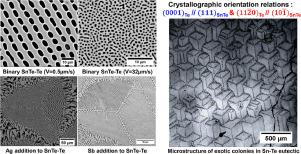当前位置:
X-MOL 学术
›
Acta Mater.
›
论文详情
Our official English website, www.x-mol.net, welcomes your
feedback! (Note: you will need to create a separate account there.)
Exotic colony formation in Sn-Te eutectic system
Acta Materialia ( IF 8.3 ) Pub Date : 2020-09-01 , DOI: 10.1016/j.actamat.2020.07.036 Shanmukha Kiran Aramanda , Sai Kiran Salapaka , Sumeet Khanna , Kamanio Chattopadhyay , Abhik Choudhury
Acta Materialia ( IF 8.3 ) Pub Date : 2020-09-01 , DOI: 10.1016/j.actamat.2020.07.036 Shanmukha Kiran Aramanda , Sai Kiran Salapaka , Sumeet Khanna , Kamanio Chattopadhyay , Abhik Choudhury

|
Abstract Eutectics are self-organized composite materials that exhibit a wide variety of microstructural features. Besides intrinsic materials properties like interfacial energies or diffusivities as well as the nature of the phase diagrams, the process parameters such as magnitude and orientation of the temperature gradient as well as the velocity of the growth interface influence the evolution of the microstructure. Recently, we have observed the evolution of complex patterns due to addition of ternary impurities in the binary Sn-Te system that contains, in addition to (Te), an intermetallic SnTe phase with a cubic crystal structure. This paper examines in detail the origin of such a microstructure that arises due to a two-phase growth instability induced by impurity addition. The binary eutectics (Sn-Te) and ternary eutectics (Sn-Te with an impurity addition) are directionally solidified at different interfacial velocities in order to study the morphological evolution. The binary alloy exhibits a rod-like or an interconnected string of rods morphology while the addition of a third component leads to a diffusive instability (similar to a Mullins-Sekerka instability) that results in the formation of two-phase colonies. The onset of instability depends on both the growth velocity and impurity concentration while the growth direction of the cells is normal to the {0001} planes of (Te) and {111} planes of SnTe. Through the extensive use of multiple characterization techniques, we have explored the morphological characteristics and crystallography of these colonies. The colonies have a complex internal structure that bears a three-fold symmetry reminiscent of the trigonal symmetry of the (Te) crystal, arising possibly because of strong anisotropy in the solid-liquid interfacial energy or in the kinetics of growth. For the different impurity additions (Ag or Sb), the internal eutectic morphology of the colony, due to the addition of Ag is different from that observed for the addition of Sb. The latter leads to the formation of lamellae while a rod-like feature could be observed for impurities like Ag. The complex patterns exhibit a structural hierarchy that provides opportunities for designing novel materials.
中文翻译:

Sn-Te 共晶体系中的奇异菌落形成
摘要 共晶是自组织的复合材料,具有多种显微结构特征。除了诸如界面能或扩散率之类的固有材料特性以及相图的性质之外,诸如温度梯度的大小和方向以及生长界面的速度之类的工艺参数也会影响微观结构的演变。最近,我们观察到由于在二元 Sn-Te 系统中添加三元杂质而导致复杂图案的演变,除了 (Te) 之外,该系统还包含具有立方晶体结构的金属间 SnTe 相。本文详细研究了由于杂质添加引起的两相生长不稳定性而产生的这种微观结构的起源。二元共晶 (Sn-Te) 和三元共晶 (Sn-Te 与杂质添加) 在不同的界面速度下定向凝固,以研究形态演变。二元合金表现出棒状或相互连接的棒状形态,而添加第三种成分会导致扩散不稳定性(类似于 Mullins-Sekerka 不稳定性),从而导致两相菌落的形成。不稳定的开始取决于生长速度和杂质浓度,而电池的生长方向垂直于 (Te) 的 {0001} 面和 SnTe 的 {111} 面。通过广泛使用多种表征技术,我们探索了这些菌落的形态特征和晶体学。菌落具有复杂的内部结构,具有三重对称性,让人想起 (Te) 晶体的三角对称性,这可能是由于固-液界面能或生长动力学的强各向异性所致。对于不同的杂质添加(Ag 或 Sb),由于添加 Ag 导致的菌落内部共晶形态与添加 Sb 时观察到的不同。后者导致形成薄片,而对于像 Ag 这样的杂质可以观察到棒状特征。复杂的图案表现出结构层次,为设计新材料提供了机会。对于不同的杂质添加(Ag 或 Sb),由于添加 Ag 导致的菌落内部共晶形态与添加 Sb 时观察到的不同。后者导致形成薄片,而对于像 Ag 这样的杂质可以观察到棒状特征。复杂的图案表现出结构层次,为设计新材料提供了机会。对于不同的杂质添加(Ag 或 Sb),由于添加 Ag 导致的菌落内部共晶形态与添加 Sb 时观察到的不同。后者导致形成薄片,而对于像 Ag 这样的杂质可以观察到棒状特征。复杂的图案表现出结构层次,为设计新材料提供了机会。
更新日期:2020-09-01
中文翻译:

Sn-Te 共晶体系中的奇异菌落形成
摘要 共晶是自组织的复合材料,具有多种显微结构特征。除了诸如界面能或扩散率之类的固有材料特性以及相图的性质之外,诸如温度梯度的大小和方向以及生长界面的速度之类的工艺参数也会影响微观结构的演变。最近,我们观察到由于在二元 Sn-Te 系统中添加三元杂质而导致复杂图案的演变,除了 (Te) 之外,该系统还包含具有立方晶体结构的金属间 SnTe 相。本文详细研究了由于杂质添加引起的两相生长不稳定性而产生的这种微观结构的起源。二元共晶 (Sn-Te) 和三元共晶 (Sn-Te 与杂质添加) 在不同的界面速度下定向凝固,以研究形态演变。二元合金表现出棒状或相互连接的棒状形态,而添加第三种成分会导致扩散不稳定性(类似于 Mullins-Sekerka 不稳定性),从而导致两相菌落的形成。不稳定的开始取决于生长速度和杂质浓度,而电池的生长方向垂直于 (Te) 的 {0001} 面和 SnTe 的 {111} 面。通过广泛使用多种表征技术,我们探索了这些菌落的形态特征和晶体学。菌落具有复杂的内部结构,具有三重对称性,让人想起 (Te) 晶体的三角对称性,这可能是由于固-液界面能或生长动力学的强各向异性所致。对于不同的杂质添加(Ag 或 Sb),由于添加 Ag 导致的菌落内部共晶形态与添加 Sb 时观察到的不同。后者导致形成薄片,而对于像 Ag 这样的杂质可以观察到棒状特征。复杂的图案表现出结构层次,为设计新材料提供了机会。对于不同的杂质添加(Ag 或 Sb),由于添加 Ag 导致的菌落内部共晶形态与添加 Sb 时观察到的不同。后者导致形成薄片,而对于像 Ag 这样的杂质可以观察到棒状特征。复杂的图案表现出结构层次,为设计新材料提供了机会。对于不同的杂质添加(Ag 或 Sb),由于添加 Ag 导致的菌落内部共晶形态与添加 Sb 时观察到的不同。后者导致形成薄片,而对于像 Ag 这样的杂质可以观察到棒状特征。复杂的图案表现出结构层次,为设计新材料提供了机会。











































 京公网安备 11010802027423号
京公网安备 11010802027423号